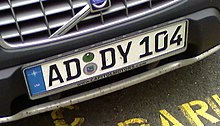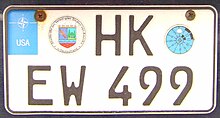License plate of the US armed forces in Germany
So-called “lookalike” license plates were issued until the end of 2005 as license plates for the US armed forces in Germany , i.e. for US soldiers stationed, civil servants with American citizenship and their family members living in Germany. German license plates have been issued since 2006. When traveling to non-EU countries, a nationality symbol (“D” or “EU”) must be affixed to the rear of the vehicle (previously “USA” sticker). German license plates are attached to new vehicles for safety reasons, but the vehicles are not subjected to the German HU and AU inspections. For the older lookalike number plates “AD”, “AF”, “HK” and “IF” were chosen, the latter being used exclusively for civil military vehicles of the US Army , for example the US military police , vehicles from AAFES and vehicles by non-appropriated funds organizations (organizations with special funds under budgetary law and bodies financed from budget funds), which from 1982 to 2000 carried the distinctive sign “NZ”.
The distinctive sign "T" is used for transfer marks, and "QQ", formerly "SH", is used for export marks.
Development up to the year 2000
The first license plates were issued in 1946. According to American law, the vehicle registration is only valid for one year and must then be extended for a further year for a fee. From 1951 to 1961 inclusive, the year of validity appeared on the license plate. Since 1962, the abbreviation “USA” has only appeared in smaller font, before that there was the inscription “United States of America” or “US Forces in Germany” on the license plate. Until 2000, the number structure was predominantly in the form "AB 1234".
In the 1960s and 1970s, the license plates were mostly green with black lettering. In the 1980s and 1990s then white with black lettering, from around the mid-1990s additionally with printed wide upper and lower black borders in order to visually approximate the height / aspect ratio to the German design. The size and format of the sign corresponded to the typical license plates in the USA (6 "× 12").
Lookalike license plate from 2000 to 2005
Due to security concerns of the US armed forces, with the approval of the German government, "lookalike" signs based on EU signs and thus inconspicuous have been used since around 2000. Since January 1, 2002, only "Euro signs" have been issued. The abbreviations “AD” (standard size) and “AF” (small size) were selected as the “approval district”, as these were the first free two-digit combinations in the alphabet. Some time later, it was discovered that "AF" can easily be associated with Allied Forces , American Forces, or Air Force . The military authorities decided to no longer assign the combination "AF" and to replace it with "HK". The combinations mentioned were given to private vehicles of members of the US armed forces in Germany. The combination “IF” is used in all license plate sizes for officially registered vehicles. The "HK" license plate was issued until the end of 2009, after which, like "AD" and "AF", it will expire and will be replaced by exclusively German license plates. "HK" has been assigned to the Heidekreis district since July 1, 2012 .
construction
The structure of the number followed the form "AD AB 123". On the left, instead of the EU star ring, the NATO emblem and the words "USA" were shown. The approval district badge read “Armed Forces of the United States of America in Germany”. The symbols of the three armed forces were depicted in the coat of arms. Instead of the HU badge - the vehicles were not subject to German law and therefore did not require a general inspection - the expiry date of the approval was given. The badge initially differed from the HU badge in that the year was marked with four digits and the months with letters (J, F, M, A ...) instead of numbers (1, 2, 3, 4 ...) and also the expiry month the admission was punched. This hole had to be at the 12 o'clock position. However, from 2004 HU badges were used according to German design (i.e. with numbers and two-digit year), but the perforation was retained. The front and rear shields were the same as there was no AU badge .
Appearance
In addition to the letter abbreviations, there were other differences to vehicles with German registration. The frequently encountered reduced license plate version, which was used for license plates with "AF" and "HK", is only given to agricultural (towing) vehicles, light motorcycles and only in rare exceptional cases to cars that do not have enough space for is the usual mark, most of which are imports from North America. Using the scaled-down version on US nationals' cars put the safety gain into perspective, as the smaller license plates were relatively easy to see from a distance. This effect was also reinforced by the fact that two-line license plates were often attached to cars where there would have been enough space for a single-line license plate in normal German size (license plate with "AD"). In addition, many private US armed forces can be recognized from a distance by their equipment and appearance, which is unusual in Germany, for example by the front tinted windows, the red rear indicators and / or side marker lights or the orange parking lights at the front.
Current development (2005 to today)
Issue of German registration
In late 2005, it was decided by the military authorities that the lookalike license plates did not provide sufficient security for the private vehicles of the US military personnel. For this reason, since December 2005, newly registered vehicles have been equipped with German license plates for the respective registration area in which the military facility is located. This does not affect externally recognizable official vehicles such as B. US Military Police vehicles; these continue to receive lookalike numbers from the “IF” series. Civilian crew vehicles of the US Army (e.g. minibuses), on the other hand, receive German civil registration plates.
In the meantime, all lookalike license plates with the exception of the "IF" have been replaced by German civil license plates. Affected are u. a. the following locations with the corresponding distinctive signs:
| Abbreviation | Locations |
|---|---|
| ON | Katterbach Heliport , Barton Barracks and Shipton Kaserne in Ansbach |
| AS | Rose Barracks in Vilseck |
| BB | Tank barracks in Boeblingen |
| BIR | Military facilities in Baumholder , u. a. Baumholder Training Area , Baumholder Airfield |
| BIT | Spangdahlem |
| COC | Büchel |
| Cap | Sheridan Barracks and Artillery Kaserne in Garmisch-Partenkirchen |
| GER | Germersheim Army Depot in Germersheim |
| HS | NATO Air Base Geilenkirchen in Geilenkirchen |
| KL | Kaiserslautern Military Community with all associated military facilities in and around Kaiserslautern |
| NEA | Storck Barracks in Illesheim |
| NEW | Grafenwoehr military training area in Grafenwoehr |
| NM | Hohenfels military training area in Hohenfels |
| S. | Stuttgart Army Airfield , Kelley Barracks , Robinson Barracks and Patch Barracks in Stuttgart |
| WI | USAREUR Headquarters, Consolidated Intelligence Center of the NSA , Lucius D. Clay Kaserne in Wiesbaden |
Since US nationals do not have to change their license plates immediately after moving within Germany as in German regulations, US vehicles with license plates from facilities that have long been closed are often in traffic for years later. The following abbreviations with former locations are still in circulation:
| Abbreviation | Former locations | move to |
|---|---|---|
| BA | Warner Barracks and Bamberg Airfield in Bamberg | |
| THERE | Dagger Complex in Darmstadt | Wiesbaden |
| HD | USAREUR Headquarters, Headquarters of the 5th US Corps, Heidelberg Army Airfield | Wiesbaden, Stuttgart, Kaiserslautern |
| GI | Distribution Center of the AAFES in Giessen | Germersheim (until 2015) |
| MA | AFN Europe and Coleman Barracks in Mannheim | Wiesbaden, Kaiserslautern |
Transfer indicator
New transfer plates have been in use since the end of 2008. They have red FE font in the spelling “TX (X) 00012”, with “T” for “Transfer” or “Temporary” and “X (X)” for the location abbreviation (one or two Letters) followed by a number with leading zeros.
| Abbreviation | Location | Abbreviation | Location |
|---|---|---|---|
| TA | Ansbach | TH | Heidelberg |
| T bra | Baumholder | T HS | Hohenfels |
| T BR | Bruchsal | TI | Ingolstadt |
| T BU | Büchel | TK | Kaiserslautern |
| T BW | Heidelberg / Mannheim | TM | Sembach (motorcycles) |
| TG | Garmisch-Partenkirchen | TS | Stuttgart |
| T GK | Geilenkirchen | T SP | Spangdahlem |
| T GR | Grafenwohr | TW | Wiesbaden |
Export indicator
Since 2009, special combinations have been issued for transporting vehicles abroad. The structure of the license plate is identical to that of the "IF" series. "SH" was awarded in 2009, "QQ" has been used since 2010. The license plates are valid for 90 days.
See also
Individual evidence
- ↑ Issuance of German license plates: http://rmv.hqusareur.army.mil/ssgerlicplat.htm ( Memento from January 31, 2008 in the Internet Archive )
- ↑ http://www.kennzeichen-guide.de/schilder/us-army.htm Kennzeichen Guide





